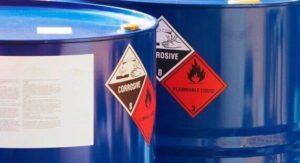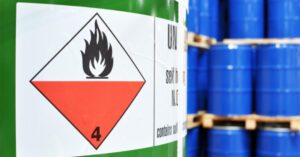How are flammable liquids categorized?
September 26, 2022
HOW ARE FLAMMABLE LIQUIDS CATEGORIZED?
At least three different federal agencies have a “stern parent” kind of interest in your flammable waste management. And psychologists will tell you: stern parents are always on the lookout for something you might be doing wrong.
So, to help you avoid any unwanted attention from eco-federales, this blog entry provides what you need to know in order to keep things neat, legal, and safe when it comes to flammable liquids and flammable waste management. Q&As include:
- What federal agencies regulate flammable liquids?
- Can state and local regulations differ from federal ones?
- What is a widget?
- What is the difference between a flammable liquid and a combustible one?
- What is a Class 3 hazardous material?
- What is a flashpoint?
- What are some examples of commonly-used flammable liquids?
- What are some examples of commonly combustible liquids?
- What are EPA rules regarding flammable liquids?
- When is a solvent considered solid waste?
- What are some of the basics for flammable liquids management?
- How can we help?
 1. What federal agencies regulate flammable liquids?
1. What federal agencies regulate flammable liquids?
Funny. We were just talking about that. It’s the DOT in matters of transportation. OSHA when it comes to workplace safety. And the EPA concerning cradle-to-grave management of flammable liquids.
But wait. There’s more. (See Q.2)
2. Can state and local regulations differ from federal ones?
Absolutely. The federal law establishing the EPA requires it to delegate primary responsibility for implementing its hazardous waste regulations to the individual states. Thus, states can differ from federal guidelines about flammable waste management. And their regulations can be more stringent than their federal counterparts.
So, regarding that rusting drum of stale gasoline, you need to get rid of from behind your widget manufactory, as we’re fond of advising, it would be prudent to get expert advice about flammable waste management before proceeding. (See Q.3)
3. What is a widget?
It’s a small gadget or mechanical device, especially one whose name is unknown or unspecified (see source). Why do you ask?
 4. What is the difference between a flammable liquid and a combustible one?
4. What is the difference between a flammable liquid and a combustible one?
Although “combustible” might sound more dangerous to some than “flammable,” the opposite is actually true. Flammable liquids ignite more readily than combustible ones.
More specifically, flammable liquids can ignite at normal working temperatures (e.g., gasoline and—believe it or not—hand sanitizer). Combustible ones require higher than normal temperatures to catch fire, making them relatively safer to use and/or store (e.g., engine oil).
Both flammable liquids and combustible ones are categorized as Class 3 hazardous materials by the EPA. (See Q.5)
And just so you know: a liquid is classified as “flammable” if it has a flashpoint at or below a given level, generally in accordance with the United Nations Globally Harmonized System of Classification and Labeling of Chemicals criteria, which is at or below 199.4 °F or 93 °C. (See Q.6)
5. What is a Class 3 hazardous material?
Every hazardous material is assigned to one of nine classes, and flammable and combustible liquids are simply #3. The nine hazard classes are as follow (see source):
1. Explosives
2. Gases
3. Flammable and combustible liquids
4. Flammable solids
5. Oxidizing substances, organic peroxides
6. Toxic substances and infectious substances
7. Radioactive materials
8. Corrosives
9. Miscellaneous hazardous materials
 6. What is a flashpoint?
6. What is a flashpoint?
The flashpoint is the lowest temperature at which something will ignite—if there’s a source of ignition. Contrast this with something called autoignition temperature, which is the point at which something will spontaneously ignite without an ignition source.
The boiling point is the temperature at which a liquid starts to vaporize, become a gas, and float into the atmosphere—which is another thing to worry about when it comes to flammable liquid management.
Both boiling points and flashpoints change with altitude and atmospheric pressure—so liquids might be more volatile if you’re managing them in Leadville vs. Calipatria.
7. What are some examples of commonly-used flammable liquids?
Acetone is used as a solvent for plastics and synthetic fibers, thinning polyester resin, cleaning tools, as well as dissolving certain glues and epoxies
Toluene is used in paint thinners, nail polish removers, correction fluid (remember that stuff?), and let’s not forget: TNT aka dynamite
Diethyl ether is an erstwhile anesthetic nowadays contraindicated for its inconvenient propensity to ignite during surgery; it’s still used to make engine-starting fluid; it’s handy as a solvent in laboratories, and it can also be used as a recreational drug, albeit illegally
Alcohols are used as fuels and solvents, they include propanol, methanol, and ethanol, the last of which is the variety found in the adult beverage of your choice
Gasoline is—well, you know.
8. What are some examples of commonly combustible liquids?
Oils—such as automotive diesel, engine lubricant, and heating fuel
Acetic acid—most of which is used to produce vinyl acetate monomer (VAM), essential to paints, adhesives, packaging materials, and—yes—salad dressing (in vinegar)
Kerosene—widely used to power jet engines and some types of rockets when not being deployed to fire up the Weber. Factoid: globally, an estimated 500 million households still depend on fuels, particularly kerosene, to light up the joint
Linseed oil—extracted from flax seed; used as a preservative for wood and concrete; an ingredient in paints, varnishes, and stains; also used in soaps, inks, and linoleum
Ethylene glycol—is used to make antifreeze, coolants, and HVAC heat-transfer fluids; this stuff also shows up in clothing, pillows, upholstery, and carpet polyesters. Oh… and we should mention bowling balls
9. What are EPA rules regarding flammable liquids?
If your own or manage any kind of manufacturing enterprise, then it’s extremely likely that you’re using solvents deemed either flammable or combustible by the EPA. Thereby, you need a protocol for flammable waste management.
Unfortunately, if confusion itself were a hazardous waste, the EPA would have to consider itself an LQG—and probably out of compliance.
Submitted for your consideration in italics, we next quote from the agency’s guidance entitled, Solvents in the Workplace—How to Determine if they Are a Hazardous Waste:
“Under the RCRA hazardous waste regulations, a solvent must first be classified as a solid waste before it can be considered for classification as a hazardous waste. Under RCRA, the term “solid waste” includes solid materials, liquids, and contained gases. Solvents are solid wastes when they are discarded or recycled in a certain manner, such as when burned for energy recovery.”
Such guidance also includes:
“If you are unsure if the solvents in your facility are solid wastes, you can use EPA’s Definition of Solid Waste Decision Tool v2, which walks you through a series of decisions to help you determine whether a material meets the definition of a solid waste.”
Sadly, clicking that link will send you to a page that doesn’t work. It just mocks you, saying that it’s “loading,” when it’s clearly doing no such thing. So as we’re inclined to advise, it would do you well to get expert advice.
10. When is a solvent considered solid waste?
A solvent is considered solid waste when it’s:
- Spent, meaning it’s contaminated through use and no longer usable for its intended purpose
- Expired, meaning it’s too old to be used
- Off-specification, meaning it does not meet its quality specs
- Unwanted and/or unused and thereby destined for disposal
11. What are some of the basics for flammable liquids management?
- Be sure to place spent flammable liquids in containers that are Factory Mutual (FM) or UL Solutions (UL) approved for the purpose.
- Label containers immediately so that your personnel know the contents.
- Keep containers out of traffic flows and away from ignition sources.
- Schedule regular pickups from a licensed and qualified hazardous waste management company.
12. How can we help?
Our advisors and field technicians stand ready to help you dispose of your flammable and/or combustible wastes safely, cost-effectively—and perhaps most importantly: in full compliance with federal, state, regional, and local requirements.
We’re here. Thank you for reading our blog!


 1. What federal agencies regulate flammable liquids?
1. What federal agencies regulate flammable liquids? 6. What is a flashpoint?
6. What is a flashpoint?